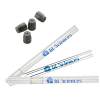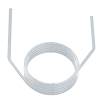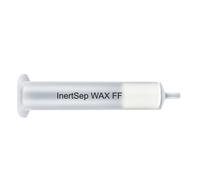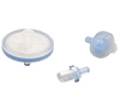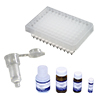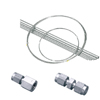Basics of Gas Chromatography
3-8 Flooded Zones and Retention Gaps
A flood zone forms when the solvent spreads as a liquid through the column because the column temperature is lower than the solvent’s boiling point. When a large volume of sample is introduced to the column, as occurs in the splitless injection method, it must be reconcentrated at the column inlet to prevent sample diffusion. If the solvent spreads unevenly, the concentration effect is insufficient and the peaks develop cracks and poor profiles. This phenomenon occurs when there is polarity mismatch between the solvent and the liquid phase of the column. It can be resolved by connecting a polarity-matched retention gap (a column of approximate length 0.3–5 m) in front of the analytical column. The retention gap ensures a uniform flooded zone in the column.
Lengths of flooded zone in various capillary columns (cm/µL) (0.3 mm I.D.; H2 = 2.5 mL/min)
|
Film
thickness |
Column
|
n-
Hexane |
Diethyl
ether |
Acetone
|
Benzene
|
Dichloro
methane |
Methanol
|
2-
Propanol |
|---|---|---|---|---|---|---|---|---|
|
0.05µm
|
OV-1
|
18
|
17
|
47
|
23
|
25
|
270
|
28
|
|
0.15µm
|
OV-2
|
20
|
16
|
80
|
19
|
17
|
230
|
30
|
|
0.30µm
|
SE-54
|
20
|
17
|
25
|
20
|
16
|
235
|
25
|
|
2.00µm
|
SE-54
|
13
|
9
|
20
|
8
|
9
|
200
|
20
|
|
0.40µm
|
OV-1701
|
26
|
19
|
23
|
20
|
8
|
240
|
30
|
|
0.22µm
|
OV-17
|
23
|
26
|
20
|
18
|
17
|
30
|
20
|
Length of the flooded zone in the column inlet and evaluation of different retention gap for capillary GC; K. Grob, H.P. Neukom, M.L. Riekkola; J. High Resol. Chromatogr. 7,319 (1984), partially deleted





